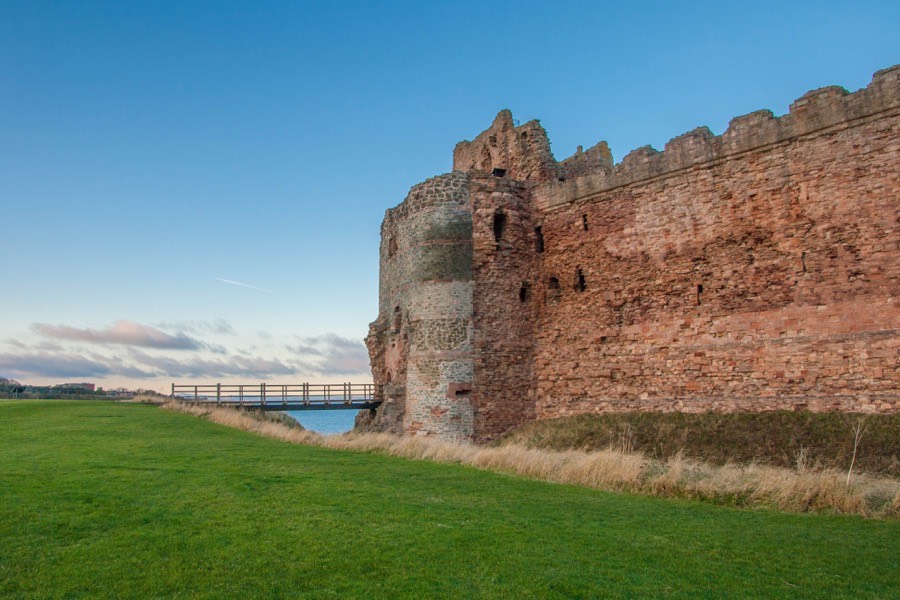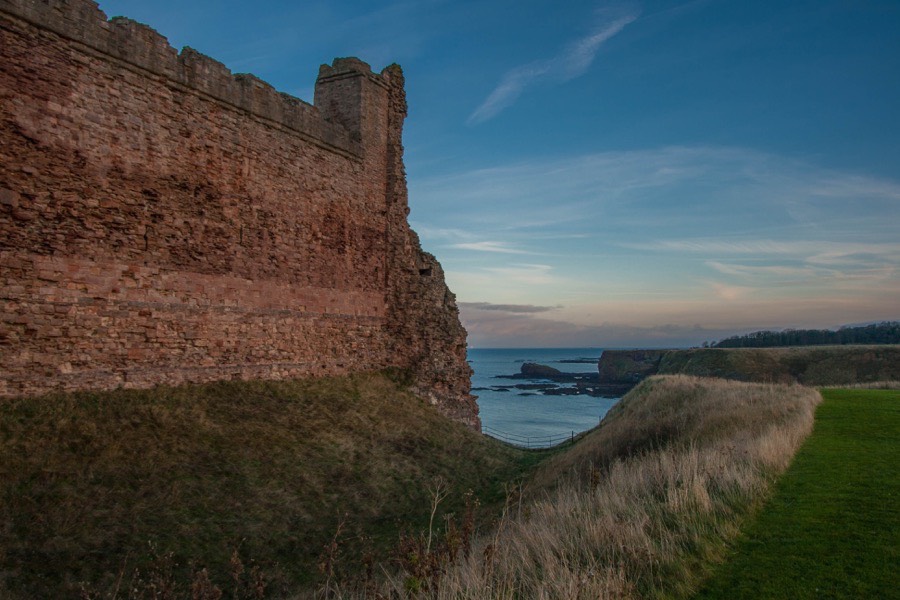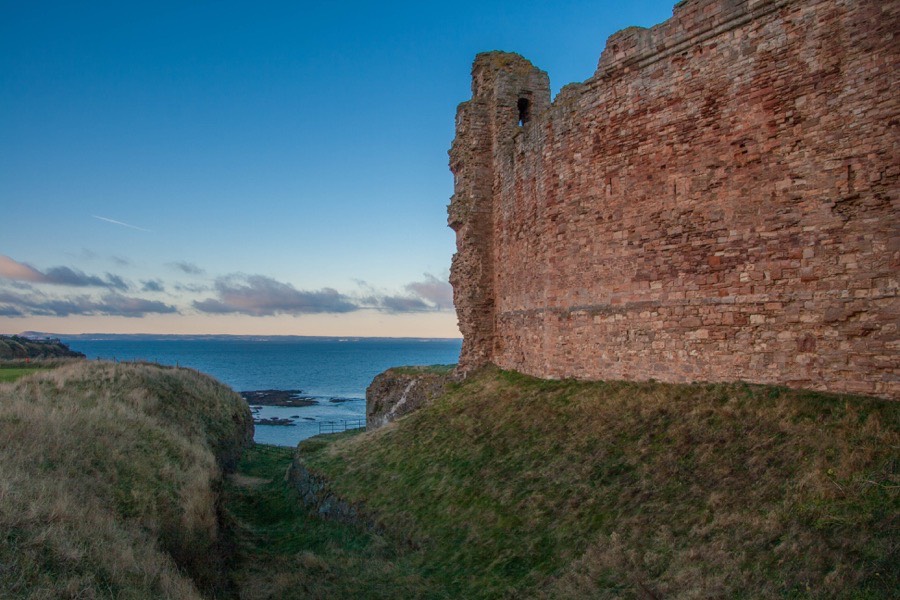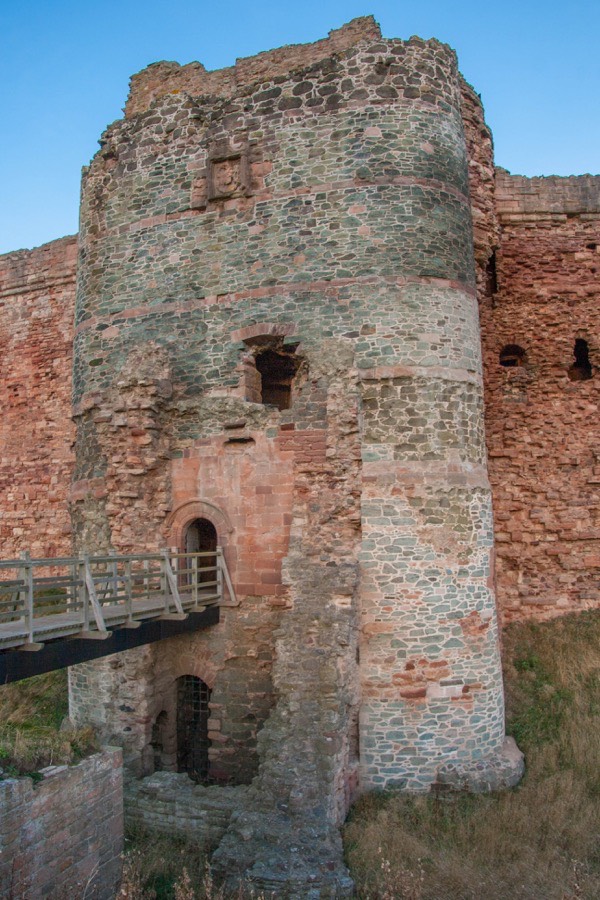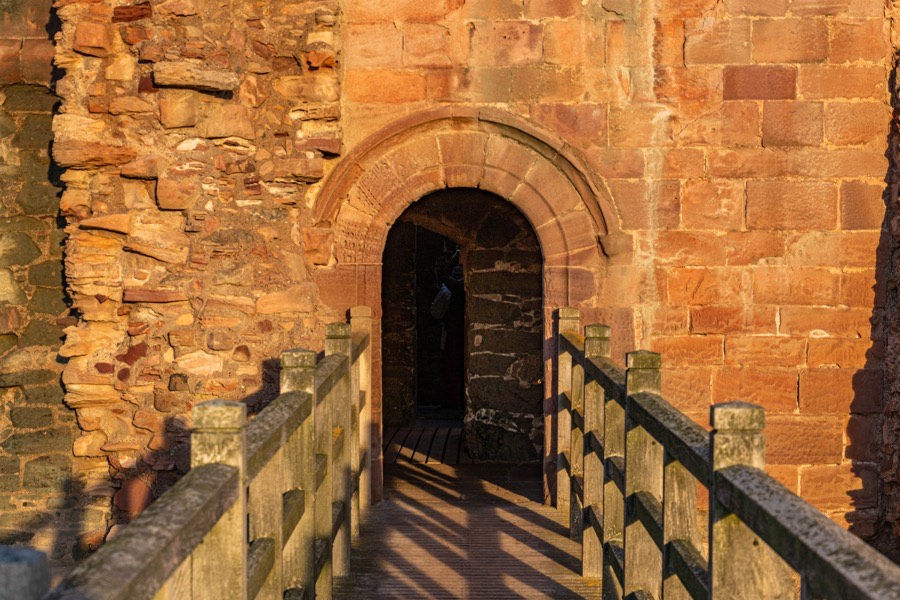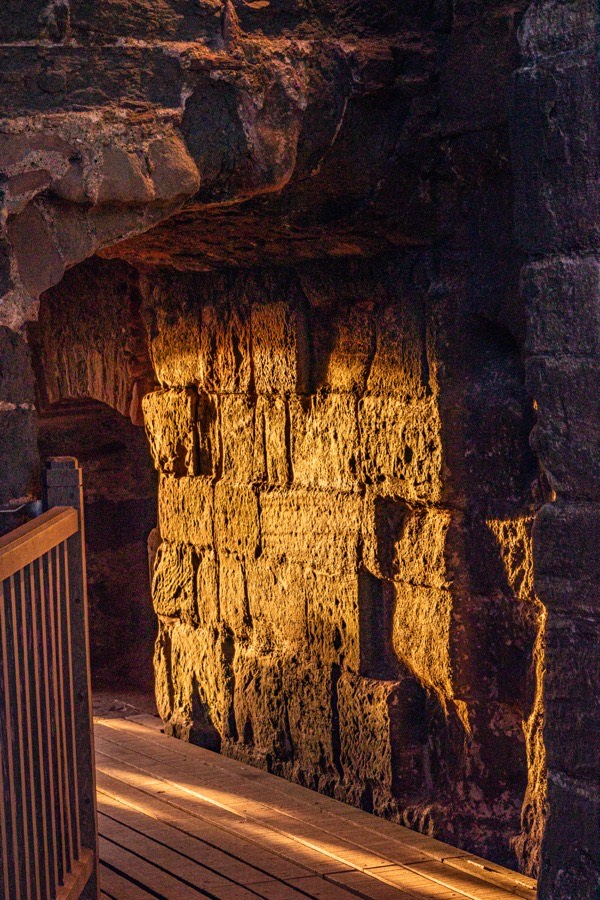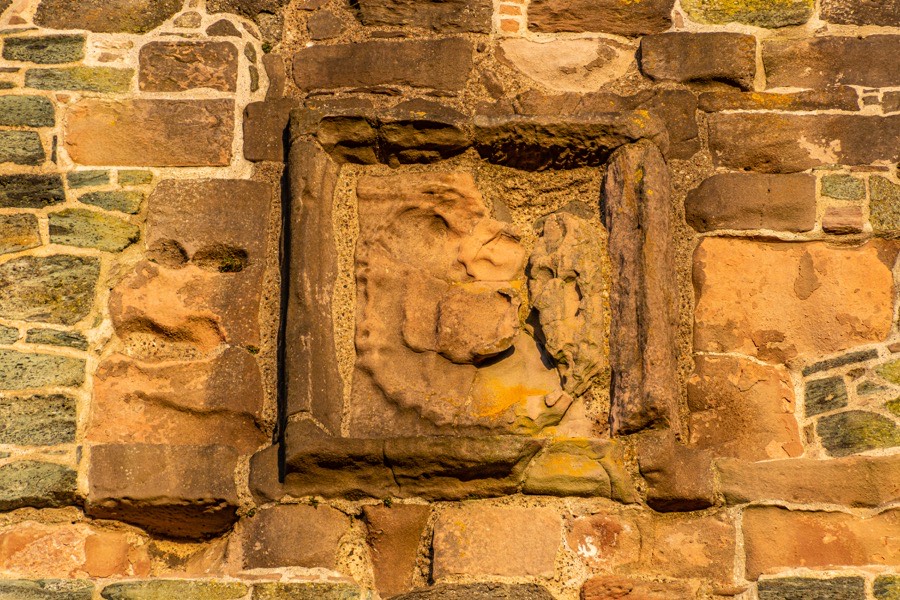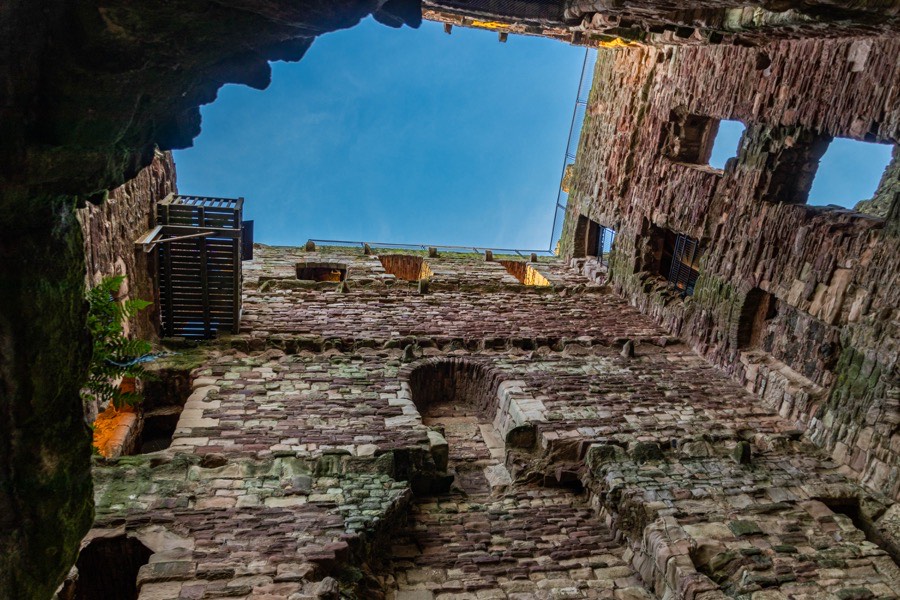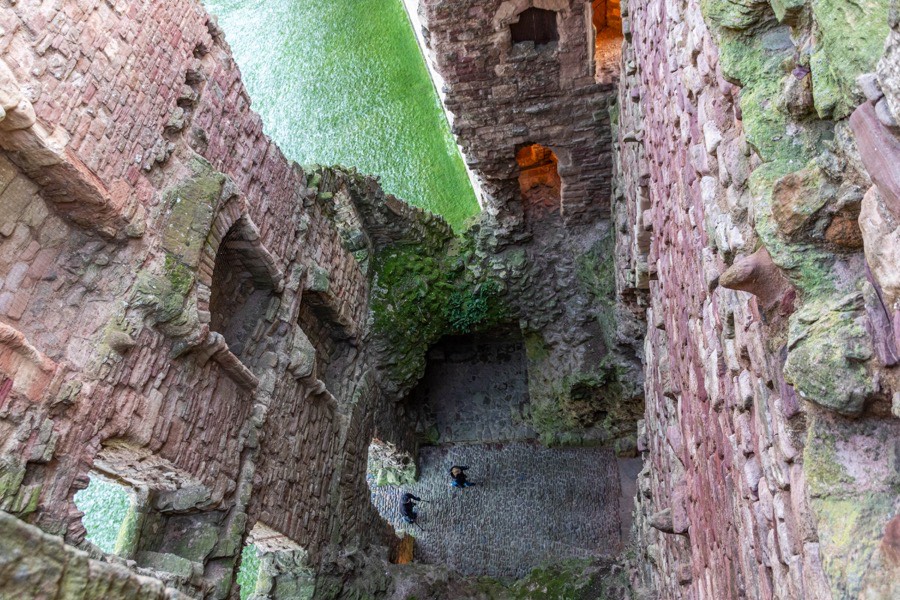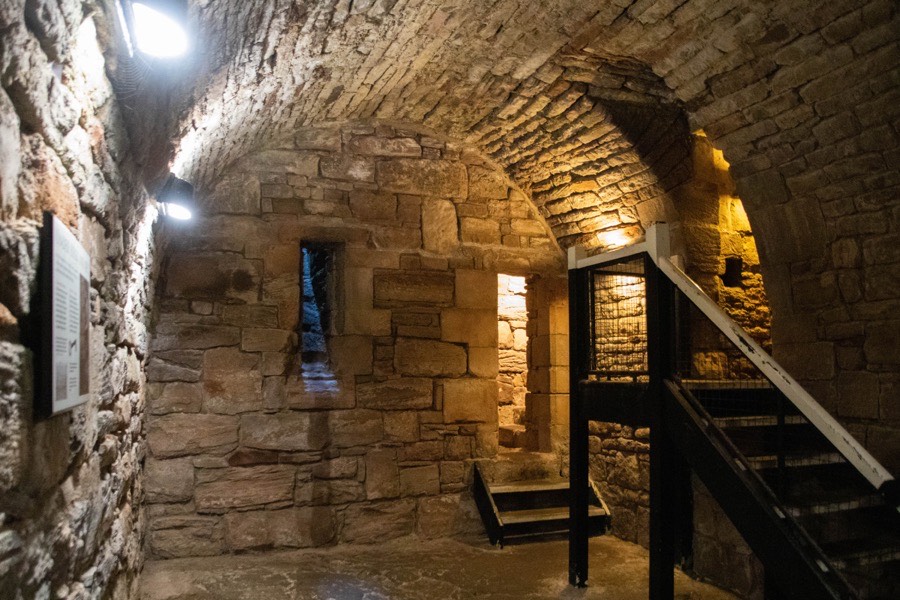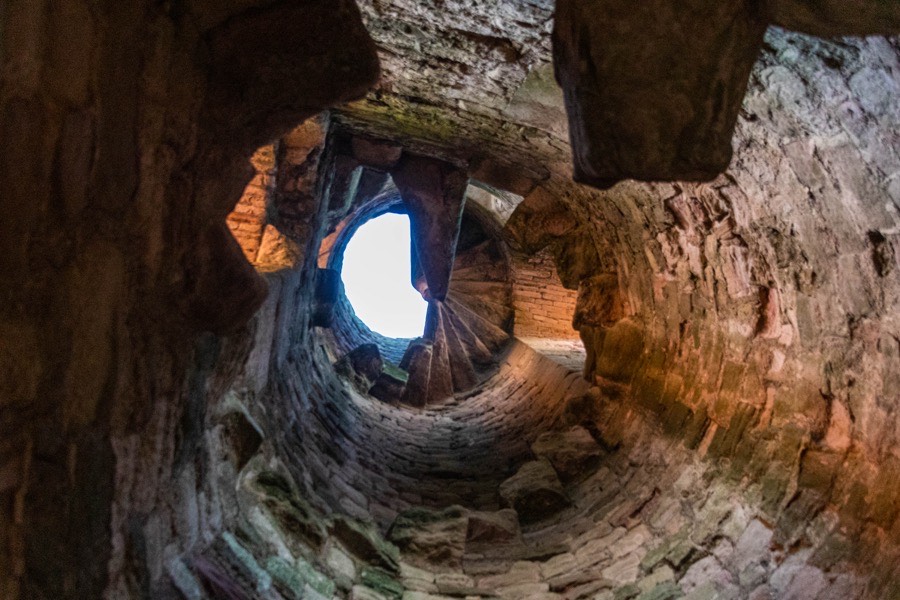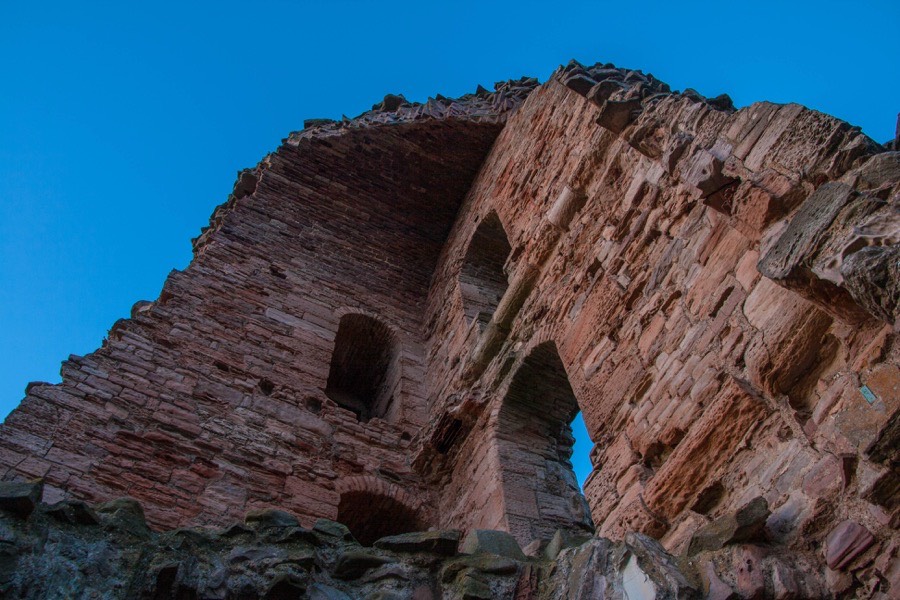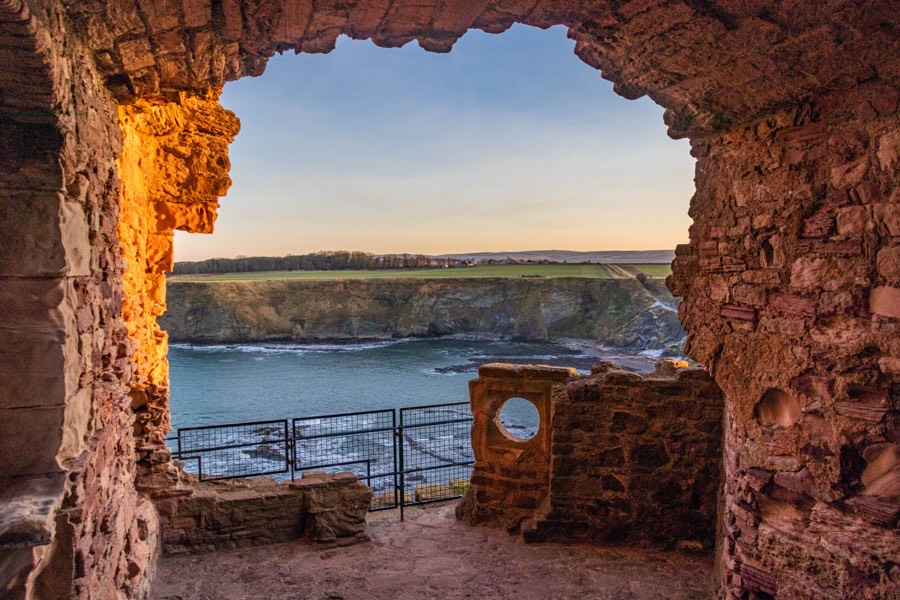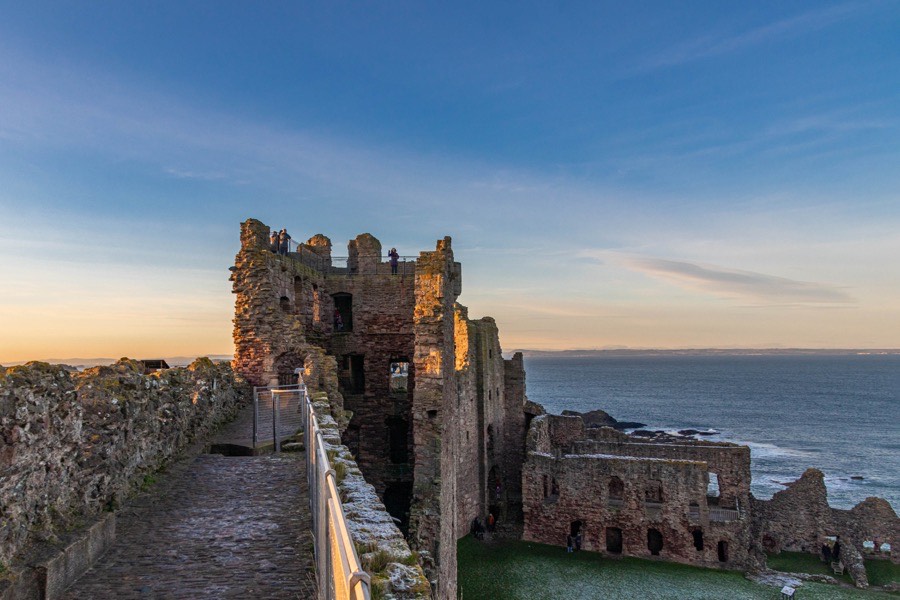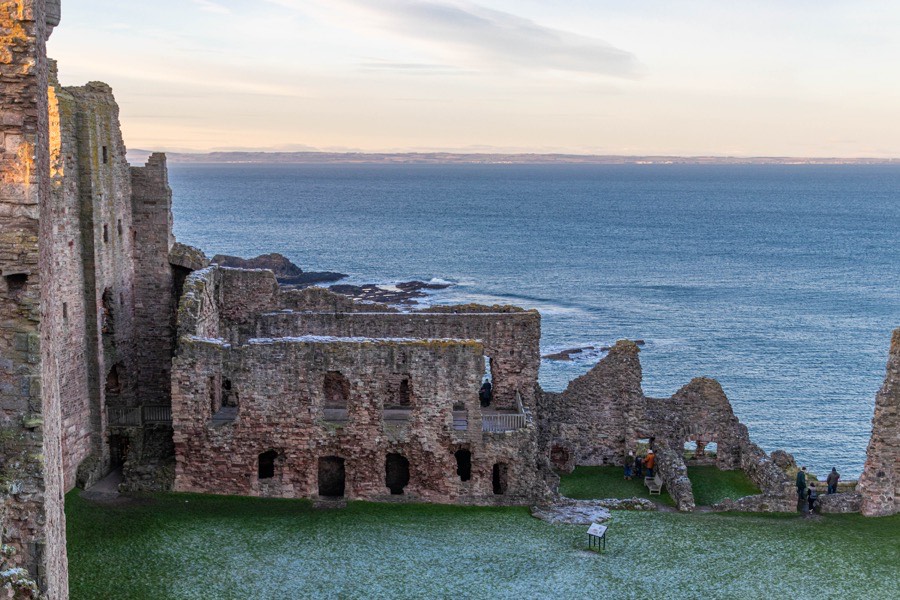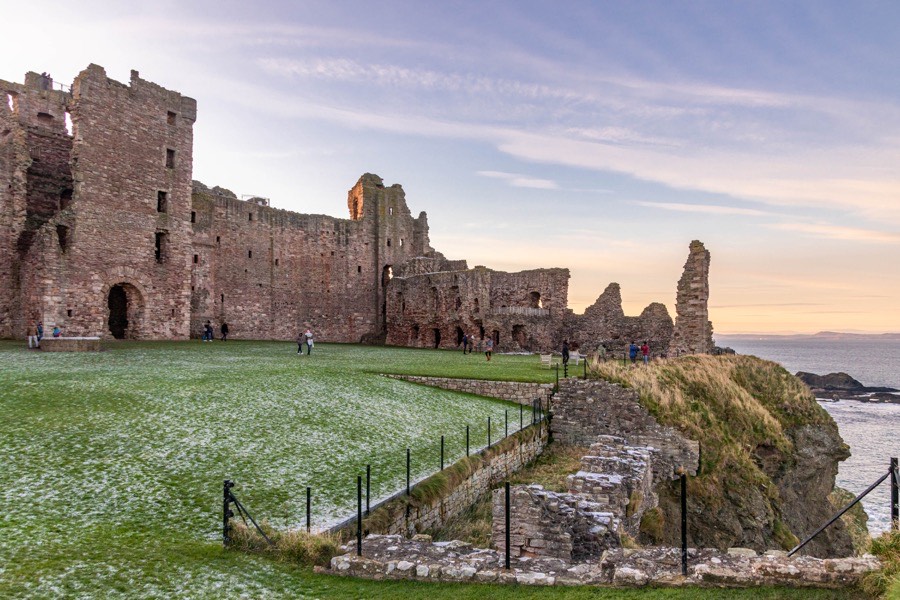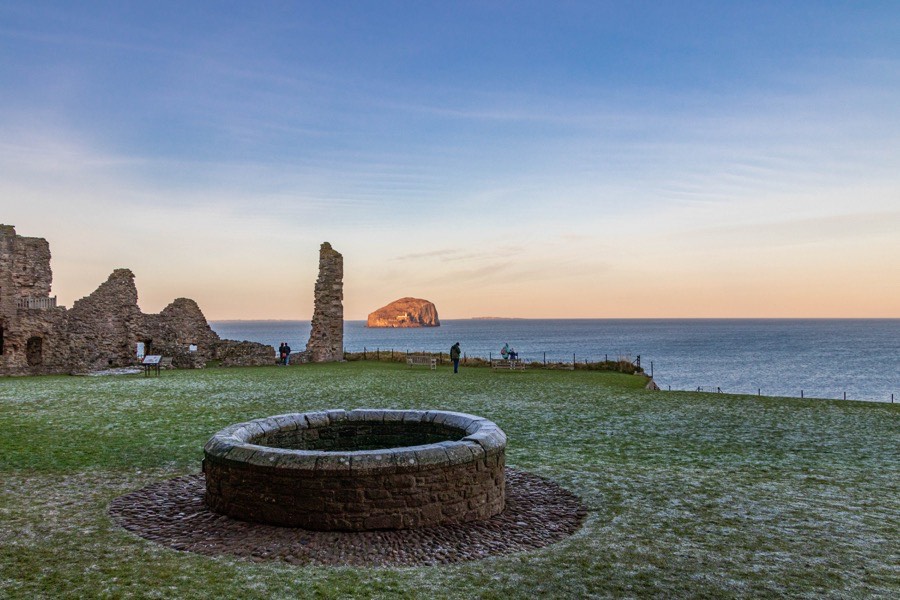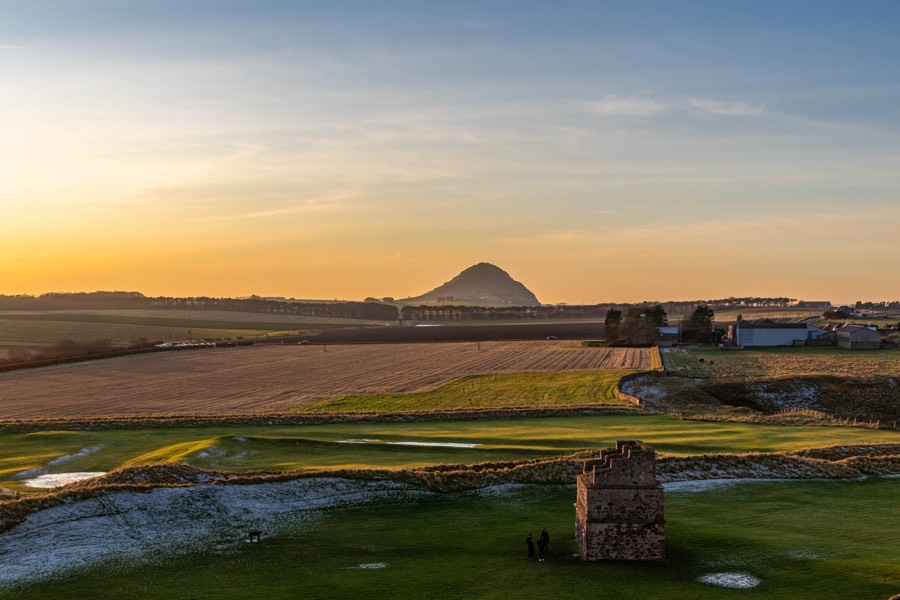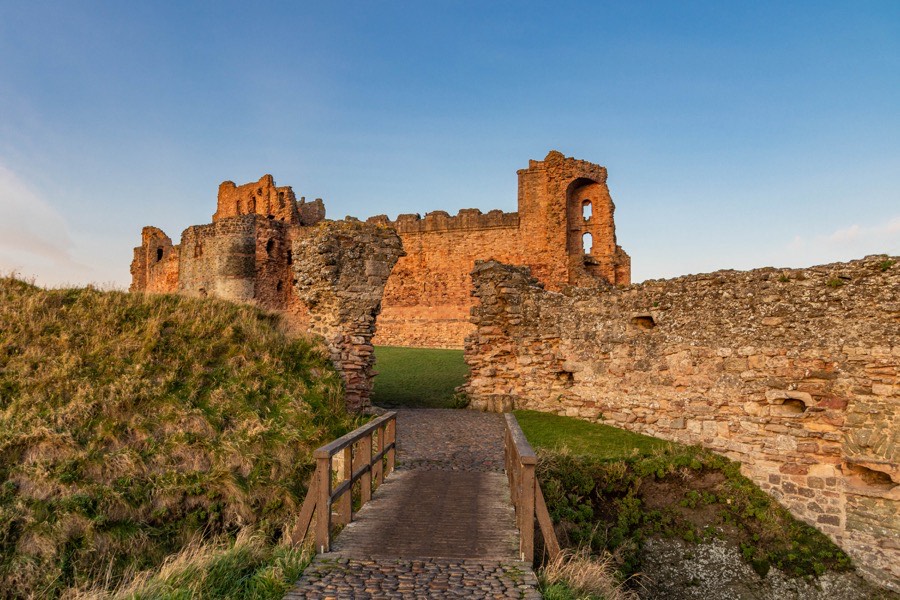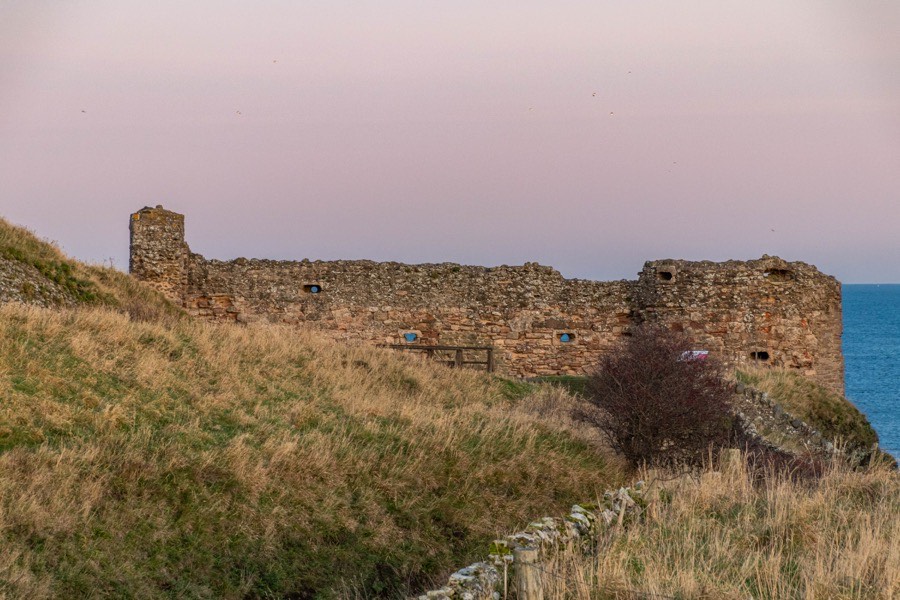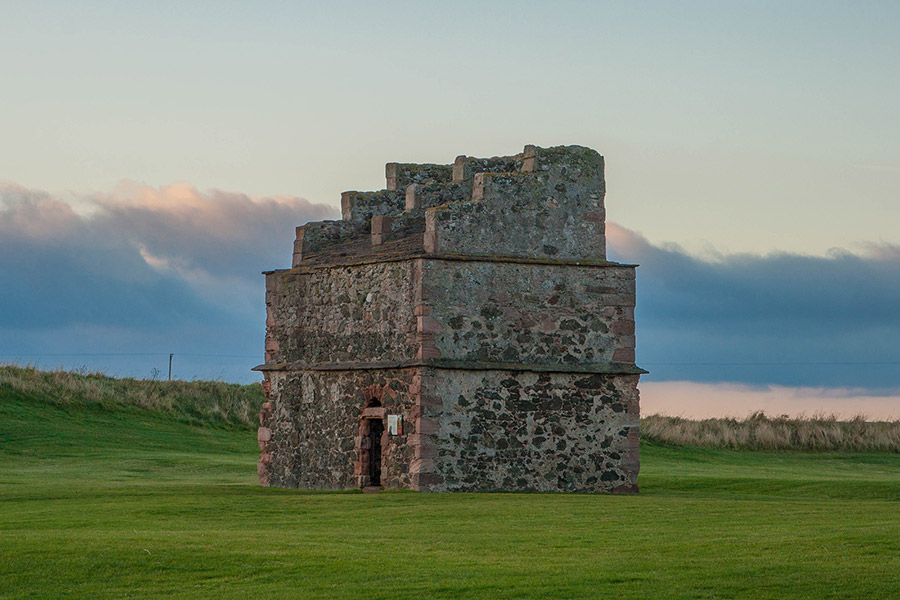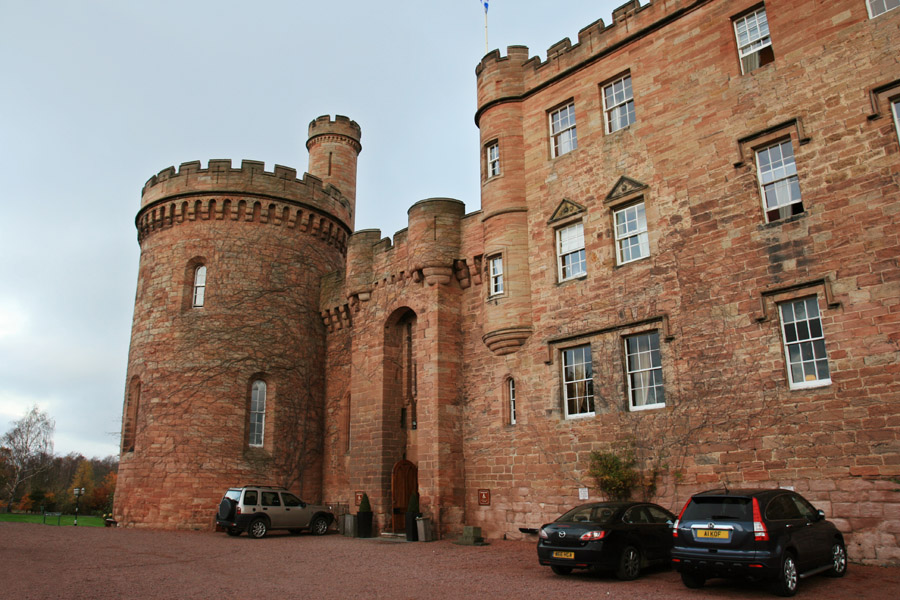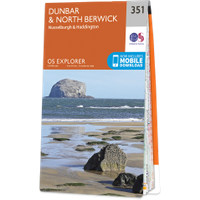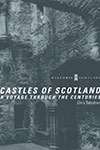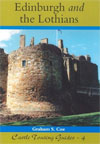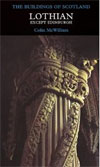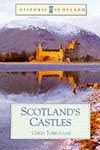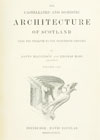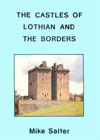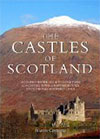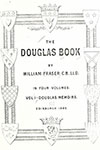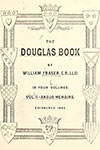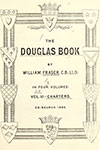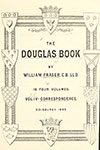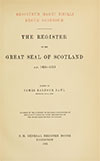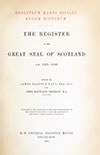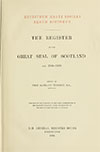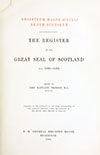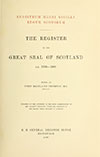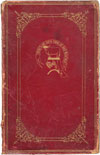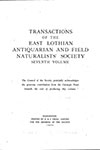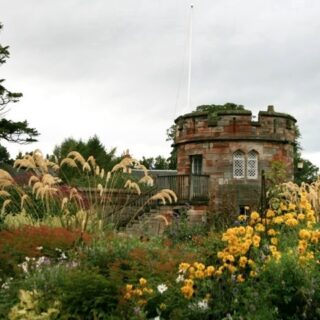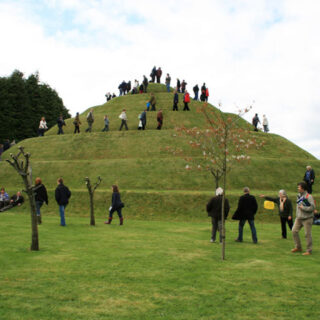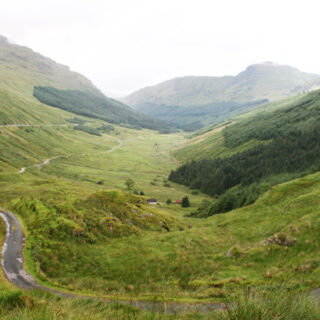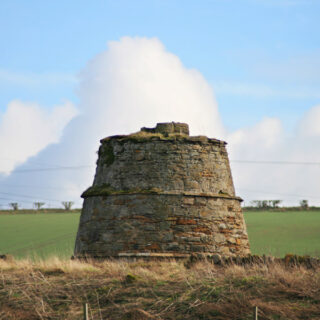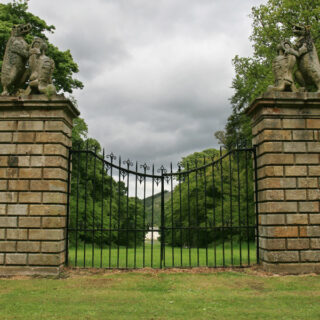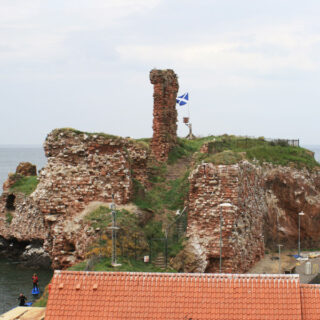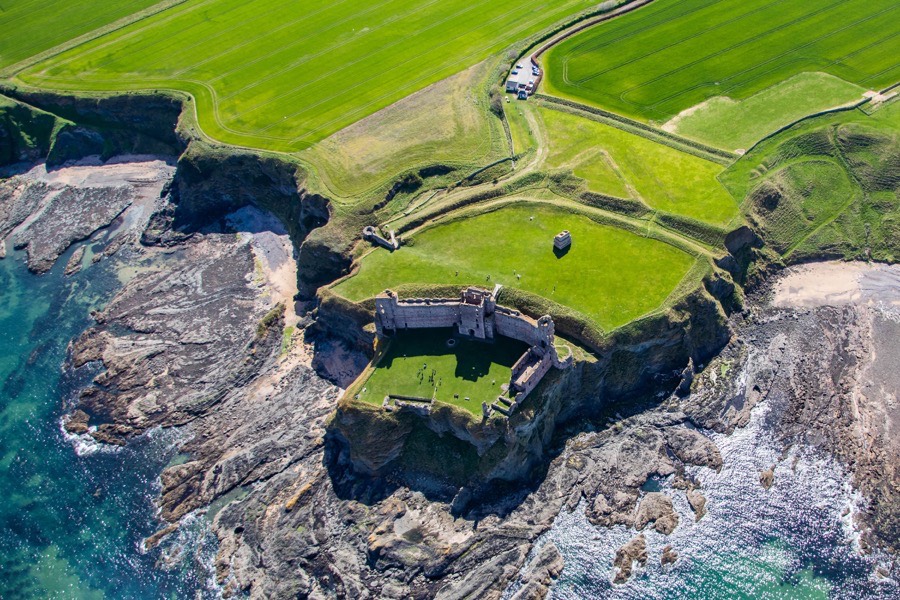
Tantallon Castle

Tantallon Castle was the last medieval curtain wall castle built in Scotland, dating to the mid 14th century, and was a power base of the Douglas family for several centuries.
The castle occupies a high promontory, around 30m above sea level, surrounded on the north-east and south sides by the sea and facing the Bass Castle on the Bass Rock. Exactly when the first castle was built on the site is not clear. The early history of the site is not known however given the natural defensive qualities of the site and the long history of occupation in the area it’s entirely possible that a fort once occupied the headland.
It’s also possible that an earlier castle pre-dated the mid-14th century building. A wide ditch cutting off the promontory has been dated to the 12th century or earlier and a castle named Dentaloune is marked on a map of Britain in the Bodleian Library which is thought to date from around 1355 but possibly based on a map from 1280. The neighbouring settlement of Castleton is referred to in 1335 suggesting that a castle was already in existence by then.
The site was once part of the barony of North Berwick which was owned by the Earls of Fife from the 10th century. In the 1320s Sir James of Douglas, also known as The Good Sir James and the Black Douglas, was granted the estate of North Berwick, as a tenant of Donnchadh IV, Earl of Fife, by Robert the Bruce. Sir James was Bruce’s trusted lieutenant. The King died in 1329 and early in 1330 The Good Sir James set off for the Holy Land carrying Bruce’s heart, however he was killed during the siege of the castle of Teba in Spain. He was succeeded by his son, William Douglas, Lord of Douglas, however he was killed at the Battle of Halidon Hill in 1333 and so the family’s properties passed to Sir James’s half-brother, Hugh Douglas, also known as Hugh the Dull.
Around this time Edward III controlled much of the south of Scotland and Hugh is thought to have lived in exile at the court of the infant David II at Château Gaillard in France. Towards the end of the 1330s Sir William Douglas, Lord of Liddesdale, fought to regain control of the Douglas territories from the English and in 1342 persuaded Hugh to resign their possessions and the Lordship of Douglas to his nephew, the young William Douglas, Sir Archibald’s son and Liddesdale’s godson. The younger William was made a ward of the Lord of Liddesdale.
David II returned to Scotland in 1341 however following the Battle of Neville’s Cross in 1346 he was taken prisoner, along with Liddesdale and other nobles, by the English. In 1348 the younger William, Lord of Douglas, returned to Scotland and set about fighting the English to regain the Douglas lands. Liddesdale pledged loyalty to England in 1352 to secure his release from captivity and when the two met while hunting in Ettrick Forest the following year William murdered his godfather.
In 1354 William was given the estates of his father, Sir Archibald Douglas, and his uncle, the Good Sir James, and is said to have begun building Tantallon Castle. The castle stands on a high promontory, around 30m above sea level, surrounded on the north-east and south sides by the sea and facing the Bass Castle on the Bass Rock to the north. The main feature of the castle is a massive defensive wall of red sandstone blocking access to the promontory, in front of which is a rock-cut ditch running the length of the wall. The wall measures around 15.0m tall and is up to 3.5m thick in places, running approximately north-west to south-east for some 61.0m.
A drawbridge across the ditch led to the main entrance gatehouse with an outer door beyond which was a vaulted passage protected by two further pairs of doors and a portcullis. Openings in the ceiling allowed the defenders to drop offensive items onto any intruders who had made it into the passageway.
High above the entrance is an armorial panel carved with a heart motif representing Robert the Bruce’s heart which his Sir James had carried to the Holy Land.
Along the length of the castle’s wall are three large projecting towers, one at each end and another in the middle containing the aforementioned gatehouse. The central tower, the Mid Tower, is around 13.0m wide, rising to a height of around 24.0m. Above the entrance gatehouse were four storeys of accommodation which included the keeper’s lodgings. These were accessed via a spiral staircase to the north within the thickness of the curtain wall.
At the north-west corner of the curtain wall was the largest tower, the seven storey Douglas Tower, a round tower which contained the Earl of Douglas’s private chambers. Almost circular in plan, it originally measured around 12.0m across although the west side has now collapsed. The basement is vaulted with a pit prison below, and each of the other six storeys features one square chamber with timber floors suspended on joists and vaulted garderobes, all reached via a spiral staircase on the south side where it joins the curtain wall.
The East Tower or South Tower, it being at the south-east end of the wall, is D-shaped with the curved side facing outwards to the west and measuring around 9.0m across. Providing ancillary accommodation this tower consists of five storeys again with a single chamber on each level, all reached via a spiral staircase on north side.
The curtain wall contains several intramural chambers serving various purposes and arched intramural staircases which lead up to the parapet walk on the top, linking all three towers.
Behind the curtain wall is a two storey range of buildings attached to the Douglas Tower, forming the north wall of the castle. This block measures around 10.0m wide by around 25.0m long and on the ground floor was the lower or Laigh Hall, later divided into three vaulted cellars, above which was the Great Hall. It originally had a pitched roof and evidence of the raggle can be seen on the Douglas Tower.
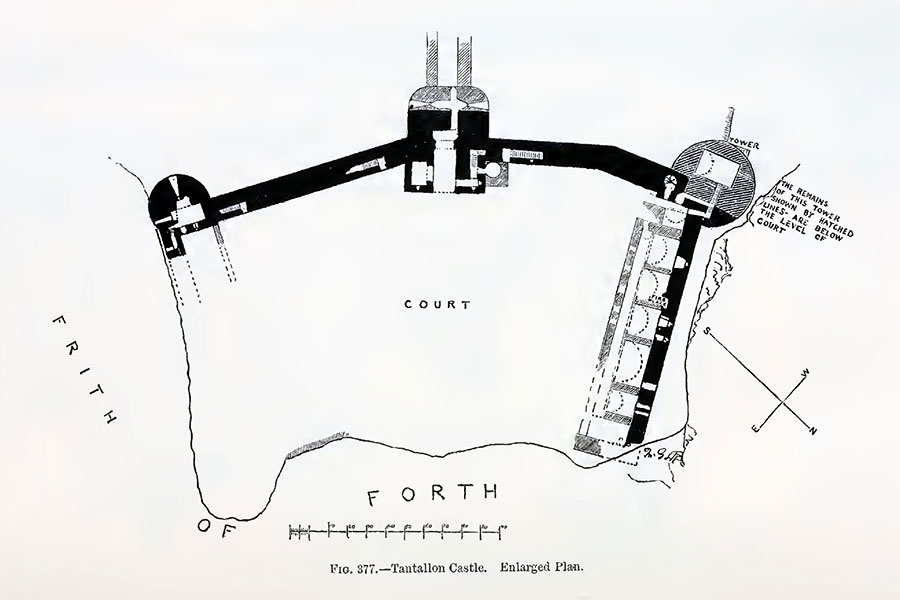
David MacGibbon and Thomas Ross, Edinburgh, 1887
The castle walls continued along the edges of the cliffs to completely enclose the inner close however most of the walls and buildings on the east and south sides have fallen into the sea below apart from a section of the east wall which features a sea gate leading down to the shore below. The area within the inner close is approximately rectangular and measures around 75.0m north-north-west to south-south-east by around 45.0m across.
Within the inner close, a short distance to the north-east of the Mid Tower, is a large well which provided fresh water for the inhabitants of the castle and is sunk some 32 metres into the rock below.
A second deeper ditch with inner and outer ramparts was constructed around 75.0m to the west of the castle, defending an outer close which would have contained ancillary buildings and accommodation for the family’s entourage. Access to the outer close was via a gatehouse at the south-east corner of the site.
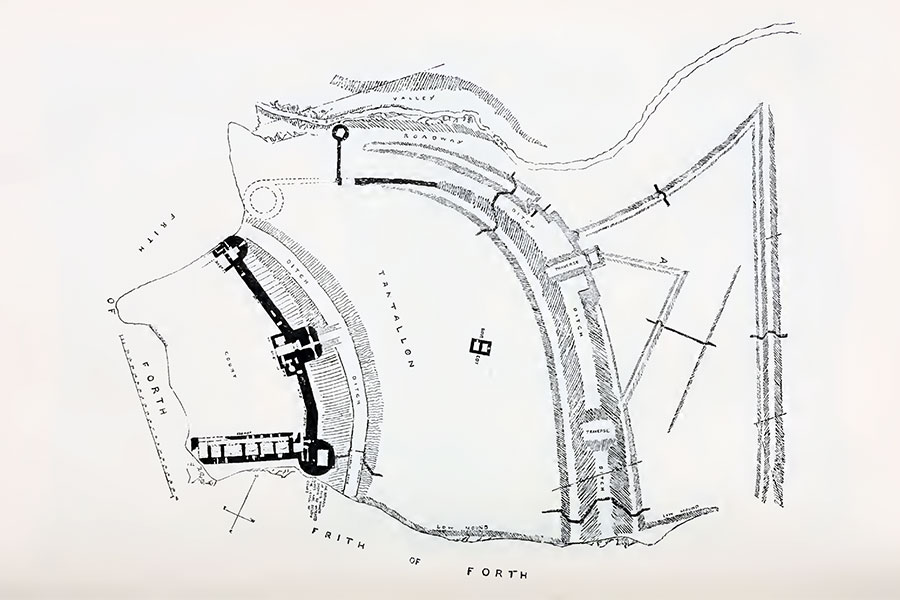
David MacGibbon and Thomas Ross, Edinburgh, 1887
In 1358 William Douglas was created 1st Earl of Douglas by David II but it wasn’t until 1374 that the first explicit mention of Tantallon Castle appears on record when the Earl referred to “our castle of Temptaloun” while describing a sea voyage to St Andrews. In 1377 the Earl made his close friend, Alan Lauder of Whitslaid, Constable of Tantallon.
The 1st Earl died in 1384 and was succeeded by his son, James Douglas, who became the 2nd Earl. The 2nd Earl was married to Isabella, a daughter of Robert II, but was killed at the Battle of Otterburn in 1388 without leaving an heir. This led Robert Stewart, the Earl of Fife and third son of Robert II, to complain to Parliament and his father that the family of James Douglas were continuing to hold “the lands of North Berwick and the castle of the same” rather than return them to their rightful owner.
The King commanded that “the freeholders and inhabitants of the said barony of North Berwick, and the warden and constable of the same castle and the others living in that castle, that in the meantime they shall answer to and obey the aforementioned earl of Fife in all ways as the superior lord of the same, and, having seen his letters, they should release and resign the same castle to him immediately, without any excuse or the raising of any difficulty.”
The Earldom of Douglas passed to a cousin, Archibald the Grim, Lord of Galloway and illegitimate son of The Good Sir James, however Tantallon remained with the 2nd Earl’s family with Margaret Stewart, Countess of Angus and Mar and the 1st Earl’s mistress and sister-in-law, residing there. An agreement was reached with the King and the Earl of Fife and in 1389 Margaret resigned her lands and titles to George Douglas, her illegitimate son with the 1st Earl, who became 1st Earl of Angus and Lord of Tantallon. The Douglas family had now split into two rival factions, the Black Douglases led by the Lord of Galloway and the Red Douglases led by the Earl of Angus. Tantallon would remain with the Red Douglas Earls of Angus for the next three centuries.
The Earl of Angus married Mary, a daughter of Robert III, in 1397 and this rise in status may have prompted the construction of a barbican in front of the Mid Tower to enhance the castle’s defences, only the footings of which now survive. The Earl was taken prisoner following the Battle of Homildon Hill in 1402 and died of the Plague the following year whilst in captivity. He was succeeded by his infant son, William, as 2nd Earl of Angus. The 2nd Earl was one of the nobles who met James I at Durham in 1424 to escort him back to Scotland following the King’s captivity in London.
In 1425 following the forfeiture of Murdoch Stewart, the Regent in the absence of James I and the Duke of Albany and Earl of Fife, the barony of North Berwick passed to the Crown and the Douglases became tenants of the King. The Duchess of Albany, Isabella, Countess of Lennox, was imprisoned in the castle following the execution of her husband and would remain there until 1433. A contemporary prisoner at Tantallon was Alexander MacDonald, Lord of the Isles, who was imprisoned there between 1429 and 1431.
The 2nd Earl of Angus died in 1437 and was succeeded by his eleven year old son, James, who soon found himself in conflict with the Black Douglases. The 3rd Earl died young in 1446 and was succeeded by his brother, George. In 1452 William Douglas, 8th Earl of Douglas, was murdered by James II during the infamous Black Dinner at Stirling Castle. The same year the King erected various lands in the barony of North Berwick into the free barony of Tantallon for the 4th Earl of Angus.
The 8th Earl of Douglas’s younger brothers rose up in rebellion but rather than supporting his rival Douglas cousins the 4th Earl of Angus threw his support behind the King, a first cousin once removed. In 1455 he led the Royal army at the Battle of Arkinholm which effectively spelt the end of the Black Douglases. The Earl of Angus grew in power and influence and in 1460 he was by the King’s side at the siege of Roxburgh Castle when James II was killed by an exploding bombard. As Lord Abernethy he placed the crown on the young James III’s head at his coronation at Kelso Abbey later that year.
The 4th Earl died in 1463 and was succeeded by his son, Archibald, also known as “Bell-the-cat”, as 5th Earl of Angus. The 5th Earl began to plot against James III, an unpopular monarch, in 1482 and in 1488 was one of the rebels who fought at the Battle of Sauchieburn when the King was killed. In 1491 he entered into a pact with Henry VII of England and in October of that year Tantallon Castle was besieged from land and sea by James IV although it apparently suffered little in the way of damage and the 5th Earl later returned to favour.
In September 1513 the 5th Earl’s two eldest sons were killed at the Battle of Flodden. He died the following month at Tantallon and was succeeded by his grandson, Archibald, who became 6th Earl despite being described as a “young, witless fool” by his uncle, Gavin Douglas, Provost of St Giles in Edinburgh. The 6th Earl however would go on to become on the most powerful nobles in 16th century Scotland. In 1514 he married Margaret Tudor, widow of James IV, mother of James V and sister of Henry VIII of England. This marriage ended Margaret’s Regency and led to the French-born John Stewart, Duke of Albany and James II’s grandson, being installed as Regent in 1515 according to the terms of James IV’s will.
Albany seized Tantallon in the same year however it was returned to the Earl of Angus when he made his peace with the Regent and the pro-French faction, and Margaret fled to England. Around 1520 a new gun tower and traverse wall were built to the south of the castle, at the south-east end of the outer ditch, beside the gatehouse leading into the outer close. The tower features wide horizontal splayed gunloops of a new type which were first built in Scotland at Dunbar Castle at a similar time.
In 1521 the 6th Earl was charged with treason and sent into exile in France, however he escaped to London in 1524 and returned to Scotland having made a pact with Henry VIII. The following year he attempted a coup d’état with a pro-English faction, seizing the young James V and being made Lord Chancellor. The young King was technically in the care of the Earl of Angus but was effectively held prisoner in Edinburgh Castle for two and a half years.
However in 1528 James V escaped to Stirling Castle and gathered nobles loyal to the Crown. The Earl of Angus was attainted and banished north of the River Spey although he instead retreated to Tantallon. The King brought guns from Dunbar Castle to attack the castle which was besieged on and off for a year. In 1529 the Earl of Angus managed to flee to England and the garrison eventually surrendered following negotiation, the castle having been badly-damaged.
Following the end of the siege ownership of Tantallon passed to the Crown and James V granted it to his royal secretary, Thomas Erskine of Haltoun. The castle was substantially rebuilt and refortified, with the red sandstone being repaired using green-tinged basalt making the changes easy to identify. The basalt was quarried from the ditch in front of the curtain wall, the ditch being widened at this time. The intramural chambers of the curtain wall were filled with rubble, as were parts of the south tower, to better withstand artillery attacks. More gun ports added at ground level.
A fore tower was added to the front of the Mid Tower, with rounded edges for additional strength, and the entrance passage was made narrower. The bottom three storeys of the East Tower were reduced to two with the insertion of stone vaulted ceilings for increased strength and large gunloops were added to the basement. The gun tower and wall at the outer gate were strengthened.
It may have been at this time that two caponiers were built in the outer ditch. A caponier is a building within a ditch which allows the defenders to fire along the ditch should it have been breached by the attackers, and two mounds within the ditch have been suggested as the remains of caponiers. Sir James Hamilton of Finnart, later the King’s Master of Works, had been present for part of the siege and was involved in the rebuilding. He was responsible for building the only other known examples in Scotland at Craignethan Castle and Blackness Castle.
Around this time, or possibly slightly later, the hall block was remodelled to form the family’s main living quarters, replacing the accommodation in the Douglas Tower. The Laigh Hall was divided into three vaulted cellars and the whole block extended to around 40.0m length to accommodate three further chambers including a kitchen and bakehouse.
In 1536 James V granted Tantallon to James Stewart, his infant son with his favourite mistress, Lady Margaret Erskine. The King seems to have stayed at Tantallon during July and August of 1537 as several charters were issued from there.
The 6th Earl remained in England until the death of James V in 1542 and in 1543 or 1544 returned to Tantallon from exile. He allowed Sir Ralph Adler, Henry VIII’s ambassador, to use Tantallon while attempting to negotiate a peace deal between the two nations however the talks failed and in 1544 the English invaded in what became known as the Rough Wooing. Tantallon is said to have been spared due to the Earl’s English sympathies however in 1545 he switched his allegiance to Scotland, possibly as a result of English troops looting Douglas graves in Melrose Abbey.
Later that year the 6th Earl, along with James Hamilton, 2nd Earl of Arran, led the Scottish army to victory at the Battle of Ancrum Moor. Francis I of France was apparently so pleased with the defeat of the English that he awarded the Earl of Angus the Ordre de Saint-Michel, or Order of St. Michael. Tantallon doesn’t seem to have suffered during the Rough Wooing, perhaps as a result of its strength, but in 1548 the guns of Tantallon were fired at English ships during a naval battle between the English and the French.
The 6th Earl died peacefully at Tantallon in January 1557 and having left no legitimate heir was succeeded by his nephew, David Douglas, son of George Douglas of Pittendreich. However the 7th Earl died at Cockburnspath the following year and was succeeded by his infant son, Archibald. Tantallon was seized by Mary of Guise, the Regent of Scotland, and given to Sir Simon Preston of Craigmillar who carried out repairs and a comprehensive inventory of the castle was produced.
George Drummond of Blair was the keeper of Tantallon in 1558 but in 1565 James Douglas, 4th Earl of Morton took control of the castle. The 4th Earl of Morton was the great-uncle of the 8th Earl of Angus and was responsible for brining up his young nephew. The following year Mary, Queen of Scots, took possession of the castle and appointed Robert Lauder of The Bass and his son, also Robert, as keepers and Mary stayed at the castle that November.
Andrew Hume, grandson of Sir Patrick Hume of Polwarth was the Captain of Tantallon in 1577. In 1581 the 8th Earl was declared guilty of treason for supporting his great-uncle and following Morton’s execution he went into exile in England, however he returned to Scotland the following year and was pardoned. By the time he died in 1588 Tantallon was no longer the Earl’s main residence and the earldom passed to his relative William Douglas, eldest son of Sir Archibald Douglas of Glenbervie.
The 9th Earl died in 1591 and was succeeded by his son, also William. An inventory of the furnishings and armaments in the castle was made in February 1592 and in July of that year James VI took possession of Tantallon, installing Alexander Home of North Berwick as captain.
In the late 16th or early 17th century the service buildings in the outer close were strengthened to resist artillery attacks. Within the outer close is a lectern doocot which is built in a style that was popular in the early 17th century, however it has been suggested that it wouldn’t have survived two mid-17th century sieges so may date to the second half of the 17th century (unless it was rebuilt after the sieges). The doocot is aligned approximately east to west and measures around 7.6m long by around 5.2m wide. Internally it is divided into two chambers which contain a combined total of 598 nesting boxes. One chamber is accessed by an entrance at the east end of the south wall and the other by an entrance in the middle of the west wall.
The 10th Earl took up residence at Tantallon in 1608 but would be the last Earl to use it as the family’s main residence. He was exiled to France in 1609, dying in Paris in 1611 when he was succeeded by his eldest son, another William. The 11th Earl preferred to stay at Douglas Castle or Bothwell Castle.
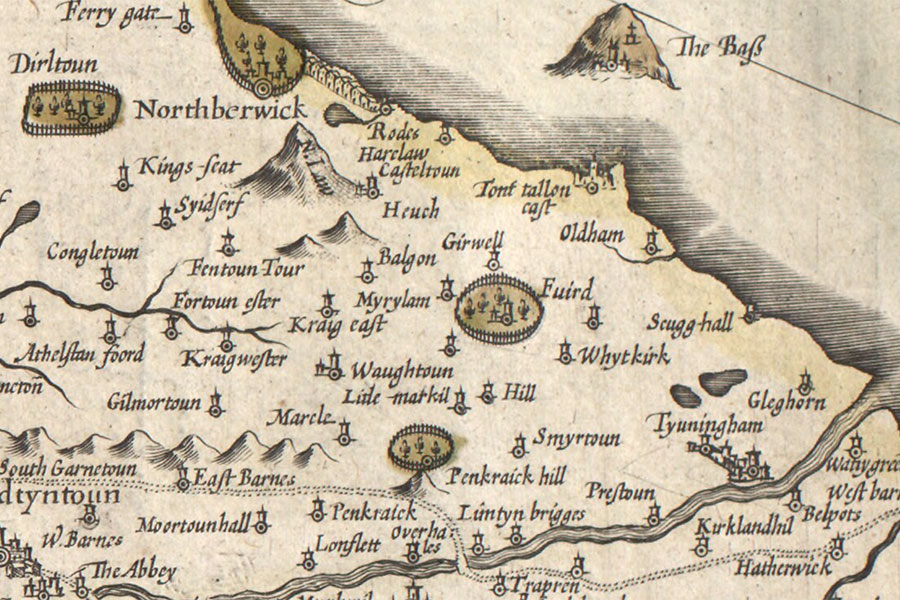
Hendrik Hondius, Amsterdam, 1630map image courtesy of NLS
When Charles I visited Scotland for his coronation in 1633 the 11th Earl was created 1st Marquess of Douglas, and as Lord Abernethy he placed the crown on the King’s head. The Earl was a Catholic which put him at odds with the Covenanters and in 1639 they besieged and captured Tantallon while he was in Edinburgh. An earthen ravelin, a triangular gun platform, beyond the outer ditch may have been constructed around this time as a similar defence was built at Threave Castle in the same year. It has been suggested that the example at Tantallon could be older however, pre-dating this particular siege.
Following his victory at the Battle of Dunbar in 1650 Oliver Cromwell controlled much of southern Scotland but his troops were being harried by Royalist forces in the North Berwick area. Dirleton Castle, Hailes Castle and Innerwick Castle were sacked and Cromwell sent 2000 troops under General Monck to attack Tantallon. The garrison of just 91 cavalry under Alexander Seton held out for 12 days before surrendering. The English guns caused a lot of damage, particularly to the Douglas Tower, and Tantallon was never inhabited again.
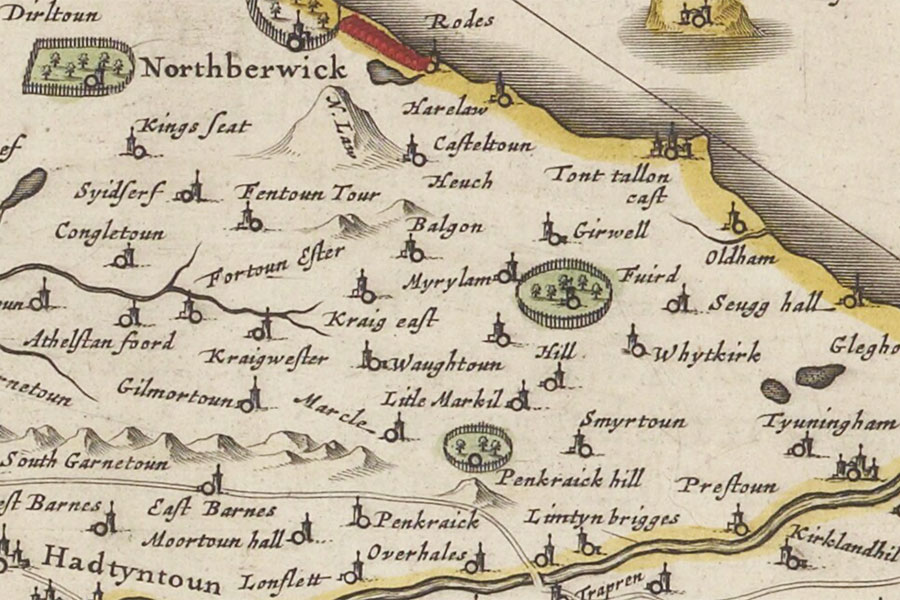
Joan Blaeu, Amsterdam, 1654map image courtesy of NLS
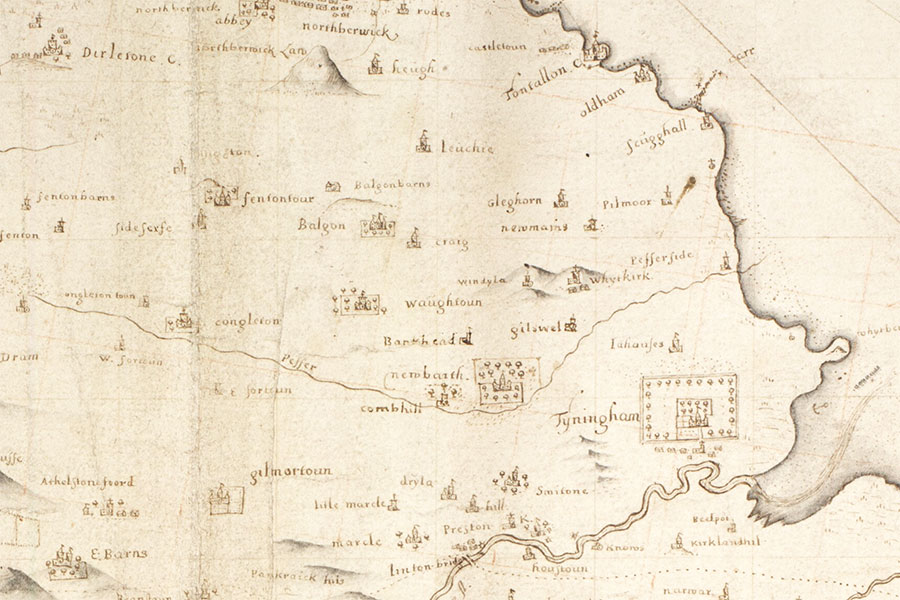
John Adair, 1682map image courtesy of NLS
In 1699 James Douglas, the 12th Earl of Angus, sold the barony of North Berwick, including Tantallon Castle, to Sir Hew Dalrymple in order to settle gambling debts. The castle’s condition was allowed to deteriorate further and in the mid-18th century some stone may have been taken from the castle to build Castleton farmhouse to the west of the castle.
A description of the castle was included in Sir Walter Scott’s epic poem “Marmion A Tale of Flodden Field”, published in 1808, which firmly established the castle’s position on the itineraries of travellers around Scotland.
But scant three miles the band had rode,
When o’er a height they pass’d,
And, sudden, close before them show’d
His towers, Tantallon vast;
Broad, massive, high, and stretching far,
And held impregnable in war.
On a projecting rock they rose,
And round three sides the ocean flows,
The fourth did battled walls enclose,
And double mound and fosse.
By narrow drawbridge, outworks strong,
Through studded gates, an entrance long,
To the main court they cross.
It was a wide and stately square:
Around were lodgings, fit and fair,
And towers of various form,
Which on the court projected far,
And broke its lines quadrangular.
Here was square keep, there turret high,
Or pinnacle that sought the sky,
Whence oft the Warder could descry
The gathering ocean-storm.
Marmion
Edinburgh, 1808
Queen Victoria visited the castle in August 1878 and took tea while seated on a sofa at the edge of the cliffs, looking out to sea. Substantial repair work was carried out for Sir Walter Hamilton-Dalrymple by the architect David MacGibbon between 1888 and 1890. The castle was scheduled in 1921 and in 1924 Sir Hew Clifford Hamilton-Dalrymple gave it to the State, with some repair work subsequently being carried out by the Ministry of Works.
In 2013 geophysical surveys were carried out on the inner close, outer close and outer defences. The survey of the inner close highlighted possible ranges of building, that of the outer close was less conclusive and the outer defences results revealed earlier rig and furrow cultivation and a further wide ditch to the west of the outer ditch. The following year archaeological excavations were carried out by Historic Scotland, with evidence of 15th and 16th century metalworking found in the inner close, the footings of 15th and 16th century buildings and a possible original entrance into the outer close, and the remains of 16th and 17th defensive earthworks beyond the outer ditch.
A second phase of excavations was undertaken in 2015. The outermost ditch was found to have been cut originally in the early medieval period, with the spoil used to build earthen banks on its east and west sides. The ditch was found to have naturally backfilled over time with pottery finds suggesting this had occurred between the 12th and 14th centuries. It was later recut, probably in the mid-17th century, to make it wider, straighter and flat-bottomed.
Today Tantallon Castle is operated as a visitor attraction by Historic Scotland and is open all year.
Alternative names for Tantallon Castle
Dentaloune; Din Talgwn; Doundallon; Tamptalloun; Tamptaloun; Tamtallan; Tamtallon; Tamtalon; Tantallan Castle; Tantallann; Tantallanu; Tantalon; Teintalon; Temptallon; Temptallone; Temptalloun; Temptalon; Temptalone; Temptaloun; Temtalloun; Temtalloune; Temtaloun; Tentallan; Tentallen; Tentallon; Thamptalloun; Thomptalloun; Thomtalloun; Tomtalon; Tont tallon; Tontallon; Tonttallon
